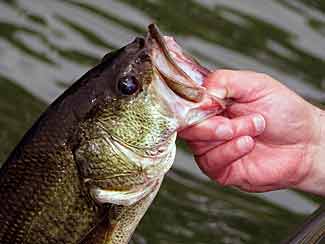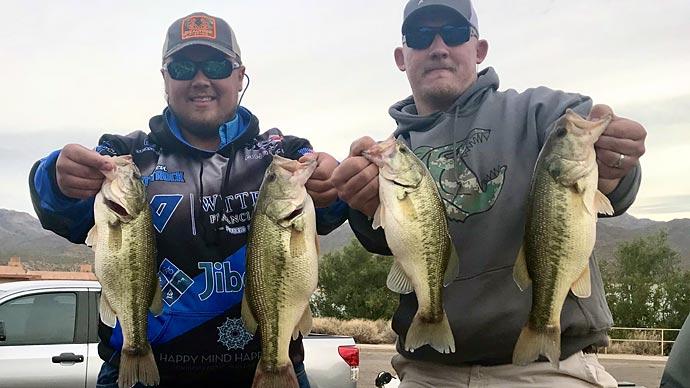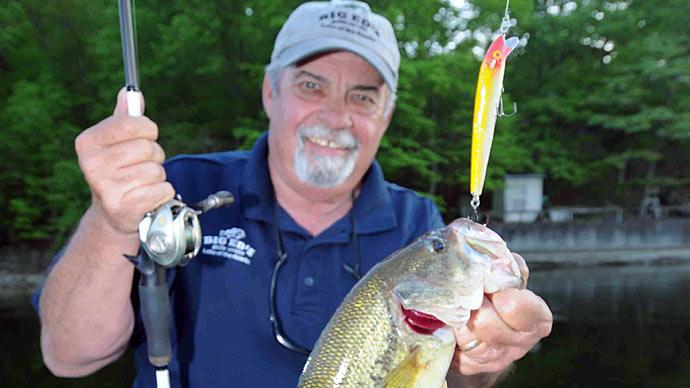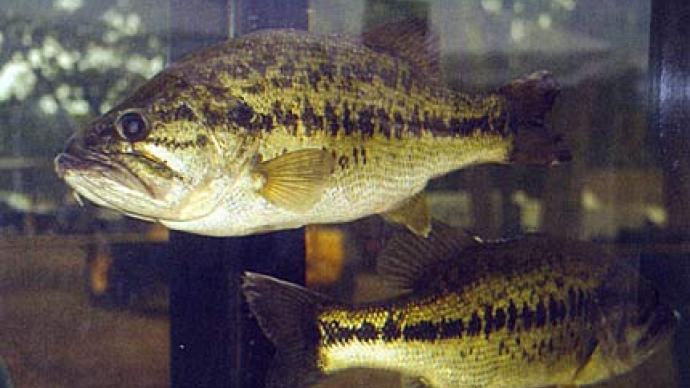
Grandpa told me a long time ago. "if they're big enough to bite, they're big enough to keep." I'll always remember his philosophies. He grew up in an era where fish were for food more than fun.
I'll also never forget the time my wife caught two bass on the same plug, undernourished fish chasing anything that hit the water. Such memories are priceless.
The philosophy and approaches to management of fish populations in ponds have changed a great deal since the good ole days. We have a much better understanding of population structure and dynamics because of research on ponds in the Midwest.
Should I keep this fish or put it back? For some people, largemouth bass have become a sacred cow and the answer is obvious. Catch and release has been a benefit to the quality of fish and fishing in many larger and public waters.
But, not so in most private waters. In lightly fished lakes/ponds there is often a surplus of eight to twelve inch bass.
It helps to make an educated decision about which fish to keep or release if you know population structure: e.g. length-frequency distribution of bass and panfish. The index of size distribution is called "proportional size distribution" or simply "PSD."
Specific lengths of fish define "stock," "quality" and "preferred" sizes. For largemouth bass these total lengths are eight, twelve and fifteen inches: for bluegill these lengths are three, six and eight inches. The index is determined as a whole number as the proportion offish longer than quality size in stock. If ten largemouth bass longer than eight inches are caught and two of those are longer than twelve inches the PSD is 20: if no fish are caught longer than 15.0 inches the PSD-P is 0. Angling is an excellent way to estimate population PSD of bass.
Tracking PSD is an excellent way to keep a running tabulation on the progress (or lack of) of your fish populations. PSD is a useful tool for a lake manager to make decisions when (and which) fish to harvest.
However, size of bluegill caught by angling does not reflect population PSD because few or no fish as small as three inches are caught. People just don't fish for tiny bluegill. When six to eight of ten bluegill caught are quality sizes the population PSD is probably between 20 and 60. Consider this a well balanced population of those key panfish. When few or no bluegill longer than six inches are caught, the PSD is likely less than ten; fish are probably stunted with slow growth and high natural mortality. Only the smallest of age-4 survive to age-5.
The number 3.0 to 5.9 inches long can be in the thousands per acre. In several Midwest ponds with a bluegill PSD less than 10. total weight of bluegill was three hundred or more pounds per acre i.e. carrying capacity for bluegill. With an increasing PSD there was a decline in bluegill standing crop such that when PSD was about 60 bluegill biomass was about 150 pounds per acre or 50% of carrying capacity.
With lower standing crop there is little competition for food and individuals grow faster, live longer and some reach preferred size. Adequate predation by bass of quality size can reduce numbers of stock and quality size down to hundreds per acre and a PSD of 60.
When the PSD of largemouth bass is less than 10 they may also be stunted and few survive to age 5. Their condition or index of well being called "relative weight" (Wr) is probably less than 90. This common population structure can result from a twelve inch minimum size limit or a preference to keep bass of quality size. The PSD of such populations can be increased with selective harvest of bass less than twelve inches while releasing all bass of quality size. This process is called, "selective harvest." Maintain that selective harvest until the proportion offish eight to twelve inches long is equal to those twelve to fifteen inches long. With these proportions the Wr of both size groups should be about 100, or the optimum value for growth efficiency: i.e. about three pounds of gain for each pound of fish consumed. When competition for food is keen and Wr is low, fish may lose weight or it may take five to ten pounds of prey for a bass to gain one pound. When there is a surplus of prey and Wr is well over I(X), growth efficiency is lower because excess protein is converted to fat.
All pond owners should spend some time keeping track of numbers and sizes caught by angling. Set up a spreadsheet in your computer and track each year's catch records by plotting bluegill PSD on the vertical axis and bass PSD on the horizontal axis. Both scales should be 0 to 100. Estimate bluegill PSD by subtracting 20 from angling PSD unless numbers are near O or 100. For the records just keep track of the numbers of bluegill shorter and longer than six inches total length. For example-if three bluegill less than six inches are caught and seven longer than six are landed, the angling PSD is 70 (7 divided by 10 x 100) and the estimated population PSD is 50. All ponds with bluegill and largemouth bass will be plotted somewhere on this graph.
Decide your management objectives. If you prefer larger bluegill, protect more bass and be satisfied with a PSD less than 30. If you prefer to catch larger bass harvest those less than 15 inches long and catch and release those of preferred size.
When the PSD's of bluegill and bass is around 60, you have reached the balance of nature, the way these populations have evolved. About 40% of bass will be 8.0 to 11.9 inches long, 40% 12.0 to 14.9 inches long and 20% longer than 15 inches. Your population will be near carrying capacity for bass and panfish populations will be near 50% of their carrying capacity. In a typical Midwest pond this could be 150 pounds of bluegill and 40 to 50 pounds of bass. This structure can be sustained by catch and release of all bass and bluegill.
You are likely to be dissatisfied with low ecological efficiency of mediocre populations of PSD less than 10 of both bass and bluegill. But, such ponds are ideal to introduce your children or grandchildren to fishing. These hungry fish are much easier to catch than fish in well balanced populations.
Some of my favorite fishing memories are from a 35 acre private lake in Boone County. Missouri. It was opened to fishing with a twelve inch minimum length limit to prevent initial overharvest of bass. After two seasons, it was obvious there was a surplus of eight to twelve inch bass. The regulation was changed to protect bass twelve to fifteen inches long, the first ever application of a "slot limit" on bass. Gizzard shad were also stocked, to help forage fish production. After two years, the Wr of bass of all sizes was over l00. Over the next five years the angling PSD of bluegill ranges from 50-90 and bass PSD ranged from 20 to 60. The regulation was considered a success.
But, for those few years with bass PSD of 10 and Wr near 90, this lake was unforgettable for my family. My daughters were about eight and ten years old at the time. They were more into "catching" than "fishing." There was a hatch of black caddis flies (Trichoptera) and bass were behaving like trout. Any cast near a rise produced a strike. I didn't catch any fish that day. Didn't have time. Only had time to unhook and release what they caught. Those memories, too. are priceless.
Maybe we should have kept those fish?
Reprinted with permission from Pond Boss Magazine



